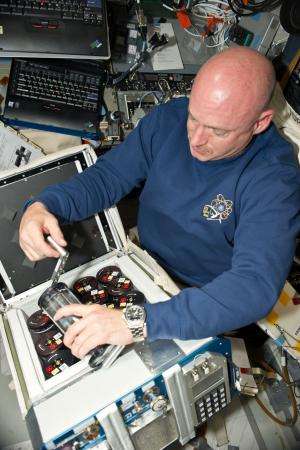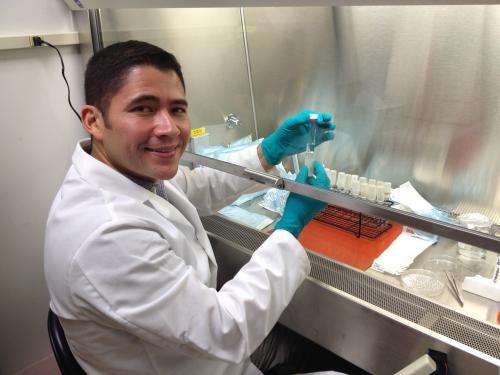Beating bacteria on Earth—and in space

By sheer strength of numbers, bacteria are by far the most successful life form on Earth. As we've learned over the past several decades of human spaceflight, they don't do too badly in microgravity either. For evidence, just look back on the astronauts and cosmonauts who were stricken with infections during their flights. At home, we have long-established and usually effective antibiotic treatments against most harmful bacteria. But previous studies have shown that in space, bacteria can survive and thrive in what would be fatal drug concentrations for them back on Earth. How is that possible?
That's a question of vital concern not just today, with International Space Station crews living together in confined spaces for months at a time, but for the future astronauts who will embark on long-duration missions to Mars and beyond. For those journeys, a quick emergency return to Earth won't be possible. Searching for the answer also helps researchers to understand the inner workings of bacteria as they seek to develop improved treatments for patients on the ground and in space.
The Antibiotic Effectiveness in Space (AES-1) investigation, scheduled to launch in January aboard the first contracted Orbital resupply flight to the space station, is a systematic attempt to probe the reasons for antibiotic resistance in space. "Is the mechanism that's allowing this to occur some form of adaptation or drug resistance acquisition within the cell, or is it more of an indirect function of the biophysical environment, the changes due to microgravity and mass transport?" asked AES-1 principal investigator David Klaus, Ph.D., of BioServe Space Technologies at the University of Colorado in Boulder.
The AES-1 investigation consists of 32 separate combinations of E. coli bacteria and various concentrations of a common antibiotic drug, either Gentamicin and Colistin. That experimental set is duplicated four times to provide a total of 128 separate data points for analysis. Upon return, researchers will check the samples for bacterial population growth. The samples will also be subjected to gene expression examinations by BioServe's study partner, HudsonAlpha Institute for Biotechnology in Huntsville, Ala.

"The idea with this first round is to determine whether the cells actually grow in what should be an inhibitory level of drug, and if so, are there any correlations with specific changes in the gene expression?" Klaus explained. Part of the AES-1 package will return to Earth with the SpaceX-3 mission in February 2014, with the remainder coming back on SpaceX-4 in the summer.
While AES-1 won't be too labor-intensive in flight, it does require a certain degree of participation by the station crew. "A few days into the mission, they'll go in and activate the 16 different group activation packs, and then periodically per the timeline they'll do a termination step on them," said Klaus. "We've flown various forms of our payload, sometimes essentially completely autonomous and sometimes with direct crew interaction."
BioServe is familiar with this type of design flexibility, with experience on 43 prior missions since 1991, including sounding rockets, Mir, space shuttle and space station flights. "You essentially begin to trade off experimental volume for automation. The more automation you have, the less [experiment volume] you can generally accommodate because of the need for the electronics and supporting systems," said Klaus.
Although Klaus and the research team plan to fly other bacterial species on future AES investigations, they decided E. coli was the best choice for this first flight. "We would ultimately like to fly things that are more clinically relevant, but for this first round, because they're so well characterized and we in BioServe have flown a lot of previous work using E. coli, it made sense to stick with this primary line we've been using for a number of years," Klaus noted. "We're going to hopefully answer the question fairly definitively in this case of whether they really are able to grow in these normally lethal levels of drugs. That's first and foremost, to repeat what's been seen in the past, but do so in a more systematic way and with a larger dataset."
Perhaps the most fascinating question to be addressed by AES-1 will be the role of the microgravity environment in potentially promoting antibiotic resistance, because bacteria are almost beyond gravity's grasp. "They're right on the threshold of being theoretically influenced by gravity directly," Klaus explained. "They're so small that Brownian motion [the random motion of tiny particles struck by atoms and molecules] is almost, but not quite dominant. If they were much bigger, gravity quickly becomes a dominant factor, and if they were much smaller, gravity becomes effectively lost in the noise. So these have made interesting models to work with. A virus is a little too small, but bacteria are right in a gray zone of neither being convective nor diffusive dominated."
Already a major problem on Earth, increasingly resistant bacterial strains can be an even greater threat for space travelers, because spaceflight can also compromise the astronaut's immune system. Couple that with bacteria's ability to grow better and resist antibiotics in space, and as Klaus noted, "that's not the right direction you want to have all those variables stacking up on you."
The hope is that a better understanding of how bacteria fight off drugs can lead to better ways to counter that resistance not only in space but back on Earth. The goal, Klaus said, is to "use the knowledge gained from observing and characterizing these interactions in the absence of gravity primarily for terrestrial benefit and secondarily for long-term astronaut crew health protection."
We will always be outnumbered by harmful species of bacteria, but we can still prevail by maintaining and improving our arsenal of antibiotic weapons. The AES-1 investigation promises to be an important step in that quest, whether we encounter our bacterial foes on Earth, in orbit, or on future distant space voyages.
Provided by NASA/Johnson Space Center



















